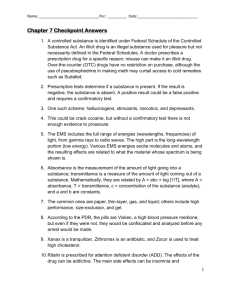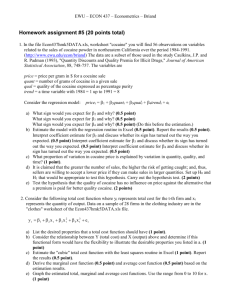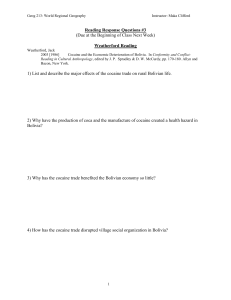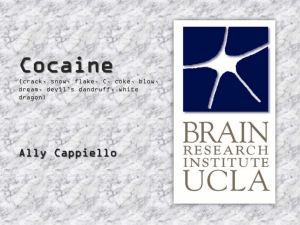Cocaine
advertisement
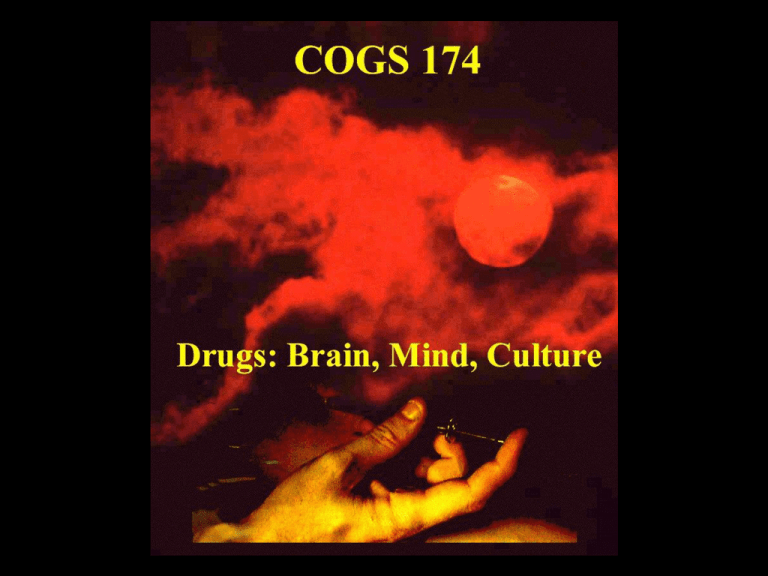
Cocaine Methamphetamine Stimulants Ephedrine Methylphenidate CNS Stimulants I. II. Cocaine, Crack (free base or hydrochloride). Amphetamines: D-Amphetamine, Methamphetamine, methylphenidate (use to treat attention deficit disorders in children), phenmetrazine (Preludin) - used to treat obesity, (hallucinogens = MDA, MDMA, DOM; methylenedioxymethamphetamine, "ecstasy," dimethoxyamphetamine). III. Khat: Cathinone, methcathinone. IV. Methylxanthines: caffeine (coffee), theophyline (tea), theobromide (chocolate). Cocaine Overview • Alkaloid from Erythroxylon coca • Indigenous to western South America • Coca leaves used for religious, mystical, social, stimulant, and medicinal purposes • Main stimulant uses: endurance, feeling of well-being, alleviate hunger • Medical uses: local anesthetic, vasoconstrictor Cocaine Production • Coca paste extracted from soaked and mashed leaves (60-80% cocaine) • Cocaine powder made by mixing paste with hydrochloric acid (cocaine HCl) • Freebase/crack extracted from powder with baking soda Amphetamine Overview (poor man’s cocaine, crystal meth, ice, glass, speed) • Synthetic analog of ephedrine, active ingredient in mahuang • Mahuang used in China for asthma – Chinese (Mandarin) má huáng : má, hemp + huáng, yellow • Methamphetamine and Methylphenidate (Ritalin) are very similar • Medical uses: obesity, ADHD, narcolepsy Chemical Structure of Stimulants National Survey on Drug Use and Health In 2009, 4.8 million Americans age 12 and older had abused cocaine at least once in the year. Cocaine use peaked in 1985 at 5.7 million. 788K use non-cocaine prescription-like stimulants; 387K of them use methamphetamine. Effects on Mind, Brain, Behavior alertness/vigilance, concentration mental acuity, sensory awareness London et al., 1999 euphoria/elevated mood brain electrical activity self-confidence, grandiosity need for sleep (insomnia) appetite brain blood flow, glucose metabolism Effects on Mind, Brain, Behavior (cont.) sexual desire, but cocaine can performance anxiety, suspiciousness, paranoia convulsions, tremor, seizure psychosis, delirium locomotion at low/moderate doses repetitiveness, stereotypy at high doses reinforcement/addiction judgement, complex multi-tasking Peripheral Effects (sympathomimetic) Fight/Flight/Fright Syndrome (sympathetic nervous system arousal) Blood pressure Blood sugar Heart rate Irregular heart beat Vasoconstriction Body temperature Bronchodialation & Impaired breathing Amph Effects on Rat Behavior Cocaine Pharmacokinetics: Absorption • Routes of administration – – – – Insufflated (snorted) IV (mainlined) Inhaled (freebased) Oral Pharmacokinetics: Distribution and Metabolism • Both cocaine and amphetamines penetrate BBB easily • Half-lives – Cocaine: ~ 50-90 min – Amphetamine: ~ 5-10 hours – Meth: ~ 12 hours • Metabolites include active and inactive compounds • Cocaine is unusual in that it “autometabolizes” in the blood in addition to normal liver metabolism. – Cocaine ----> norcocaine, ecgonine methyl ester, benzoylecgonine Cocaethylene • Alcohol inhibits metabolism of cocaine • Alcohol + cocaine chemically react to form cocaethylene • Only known example where body forms new psychoactive compound from two others • Cocaethylene – Similar effects to cocaine – Greater cardiac toxicity than cocaine – 3-5x the half-life of cocaine – associated with seizures, liver damage, compromised immune system Cocaine Pharmacodynamics • Indirect Agonist for – DA (high affinity) – NE (high affinity) – 5-HT (modest affinity) • Mechanism: – Blocks monoamine reuptake Amphetamine Pharmacodynamics • Indirect Agonist for – DA (high affinity) – NE (high affinity) – 5-HT (low affinity) • Mechanisms: – Blocks monoamine reuptake – Inhibit vesicular storage – Inhibit MAO metabolism – Reverses reuptake Tolerance, Withdrawal, Addiction • High abuse potential (Schedule 2) • Physical and psychological dependence • Tolerance to euphoria, appetite suppression; sensitization to psychomotor • Withdrawal – Physically mild to moderate (hunger, fatigue, anxiety, irritability, depression, panic attacks, dysphoric syndrome) • Dysphoric syndrome (1-5 days after the crash): characterized by decreased activity, amotivation, intense boredom and anhedonia, intense “craving” for cocaine. May last 1-10 weeks. – Anhedonia from biogenic amine depletion? – Intense cravings • Route of administration important to addiction risk Pharmacotherapies Treatment of withdrawal: • Alpha-blockers • Chlorpromazine: DA antagonist (also blocks alpha receptors) • Haloperidol (antipsychotic – 50x more potent than chlorpromazine). • Alprazolam (Xanax - benzodiazepine) for panic attacks. • Antidepressants (fluoxetine or desipramine). • Diazepam (Valium) for seizures - binds to benzodiazepene site of GABAa receptor. New Treatment Approaches IMMUNOLOGICAL • Antibodies made against cocaine, to break-down the molecule and stop its effects. • Undergoing Phase III trials in US • An inactive cholera toxin protein – attach inactivated cocaine • Immune system makes antibodies against both • When individual takes cocaine, antibodies bind to it and prevent it from reaching brain – high does not occur, patient loses interest Cocaine Concurrent or substitute use • Multiple drug use (nicotine, alcohol, heroin, amphetamines, hallucinogens). • Self-medication with sedatives to reduce agitation and induce sleep (“come down”). Cocaine + heroin => “speed ball” Cost of Methamphetamine use – 2008 (RAND Corporation) • In 2007 about 13 million Americans (ages 12 and up) reported using meth at least once in their lifetimes • Accounts for 6 - 8 percent of the total cost of drug abuse in the United States. • $23.4 billion per year costs – – – – lost lives (900 individuals died in 2005); thousands addicted productivity, drug treatment, law enforcement expenses (arresting, prosecuting and incarcerating meth users ), – economic costs of crimes committed Ritalin and ADHD: Kiddie cocaine? (6x increase since 1990) • Since Ritalin is a stimulant, how does it help rather than make things worse?! • May selectively activate mesocortical pathway, improving working memory, attention • May selectively activate mesolimbic pathway, improving motivation • Hyperactivity may be indirect result of low DA, rather than high DA in nigrostriatal pathway


